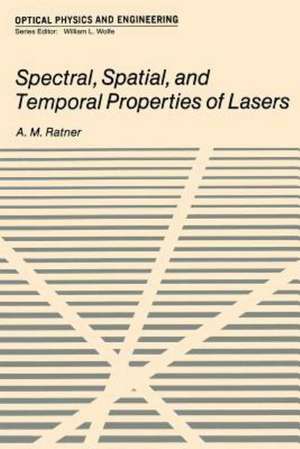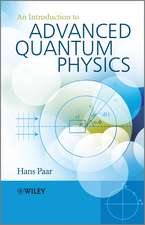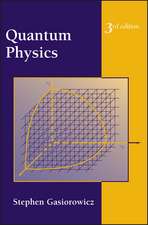Spectral, Spatial, and Temporal Properties of Lasers: Optical Physics and Engineering
Autor A. Ratneren Limba Engleză Paperback – 23 mar 2013
Preț: 384.31 lei
Nou
Puncte Express: 576
Preț estimativ în valută:
73.54€ • 78.64$ • 61.31£
73.54€ • 78.64$ • 61.31£
Carte tipărită la comandă
Livrare economică 17 aprilie-01 mai
Preluare comenzi: 021 569.72.76
Specificații
ISBN-13: 9781468419283
ISBN-10: 1468419285
Pagini: 240
Ilustrații: XIV, 220 p. 23 illus. in color.
Dimensiuni: 152 x 229 x 13 mm
Greutate: 0.33 kg
Ediția:Softcover reprint of the original 1st ed. 1972
Editura: Springer Us
Colecția Springer
Seria Optical Physics and Engineering
Locul publicării:New York, NY, United States
ISBN-10: 1468419285
Pagini: 240
Ilustrații: XIV, 220 p. 23 illus. in color.
Dimensiuni: 152 x 229 x 13 mm
Greutate: 0.33 kg
Ediția:Softcover reprint of the original 1st ed. 1972
Editura: Springer Us
Colecția Springer
Seria Optical Physics and Engineering
Locul publicării:New York, NY, United States
Public țintă
ResearchCuprins
Basic Notation.- I. Certain Information from Luminescence Theory.- § 1. Absorption and Luminescence Spectra of Impurity Luminophors.- § 2. Nonradiative Transitions Between Electronic Levels of an Impurity Atom.- § 3. Nonradiative Energy Transfer Between Impurity Atoms.- Conclusions.- II. The Threshold and Output Power of a Laser.- § 4. The Effective Absorption Coefficient.- § 5. The Threshold Pumping Power.- § 6. The Output Radiation Power of a Laser.- Conclusions.- III. The Natural Oscillations of an Ideal Resonator (Linear Theory).- § 7. The Oscillation Modes of a Closed Resonator.- § 8. The Modes of an Open Resonator.- Conclusions.- IV. The Transverse Structure of the Electromagnetic Field in a Plane-Parallel Resonator.- § 9. The Equation for the Electromagnetic Field.- §10. The Field Distribution over a Cross Section Having the Shape of a Half-Plane.- § 11. The Intensity Distribution over a Cross Section Having Finite Dimensions.- § 12. The Diffraction Losses.- § 13. The Range of Application of the Treatment. Comparison with Experiment.- Conclusions.- V. Longitudinal Structure of the Electromagnetic Field in a Plane-Parallel Resonator.- § 14. The Longitudinal Mode of a Resonator Having an Infinite Cross Section.- § 15. The Number of Simultaneously Generated Longitudinal Modes.- § 16. The Electromagnetic Field in a Resonator Having a Finite Cross Section.- §17. The Effective Absorption Coefficient.- Conclusions.- VI. A Laser with Concave Reflectors.- §18. The Equivalent Mechanical System.- § 19. Taking Account of the Active Medium.- §20. Cylindrical Mirrors.- §21. Reflectors in the Shape of a Surface of Rotation.- § 22. The Spectral Composition of the Radiation.- § 23. The Transition to a Resonator with Plane Mirrors.- § 24. An OpticalResonator with Lenses.- Conclusions.- VII. Relaxational Intensity Oscillations.- §25. The Kinetic Equations.- §26. The General Picture of Oscillations of Stimulated Emission.- §27. Oscillations Having a Large Amplitude.- §28. Damping of Oscillations and Their Amplitudes.- §29. Range of Applicability and Experimental Data.- §30. Self Oscillations.- Conclusions.- VIII. The Spectral Width of the Radiation.- § 31. The Spectral Composition of the Radiation.- § 32. The Effect of Kinetic Operation on the Spectral Width of the Generation.- Conclusions.- IX. The Threshold Phenomena Related to Microinhomogeneity of the Active Medium.- § 33. Spectral Width of Radition from a Laser with an Inhomogeneously Broadened Luminescence Line. The Basic Equations.- § 34. The Spectral-Broadening Threshold.- § 35. The Equation for the Intensity of the Polarization Components.- § 36. The Second Generation Threshold.- § 37. The Intensity of the Fundamental Component under Conditions when the Second Component Cannot Be Generated.- § 38. The Degree of Polarization of the Radiation.- § 39. Comparison with Experimental Data.- Conclusions.- X. Active Q-Modulation.- § 40. Obtaining a Single Pulse by Means of Rapid Q-Switching.- § 41. Equations for Light Energy in a Resonator with Modulated Q.- § 42. Shape of the Intensity Peak.- § 43. Effect of a Finite Q-Switching Rate and Pump Nonuniformity on the Shape of the Peak.- § 44. Stimulated Intensity Oscillations.- Conclusions.- XI. Passive Q-Modulation.- § 45. The Mechanism of Passive Q-Modulation.- § 46. The Equation for a Passive Optical Shutter.- § 47. A Passive Shutter Open Either Negligibly or Completely.- § 48. Various Operating Modes of a Laser with a Passive Shutter.- Conclusions.- XII. Mode Locking and Ultrashort Pulses.-§ 49. The Electric Field of a Multimode Laser.- § 50. Forced Mode Locking.- § 51. Self Mode Locking.- § 52. Pulse Velocity Inside the Cavity.- Conclusions.- References.


























